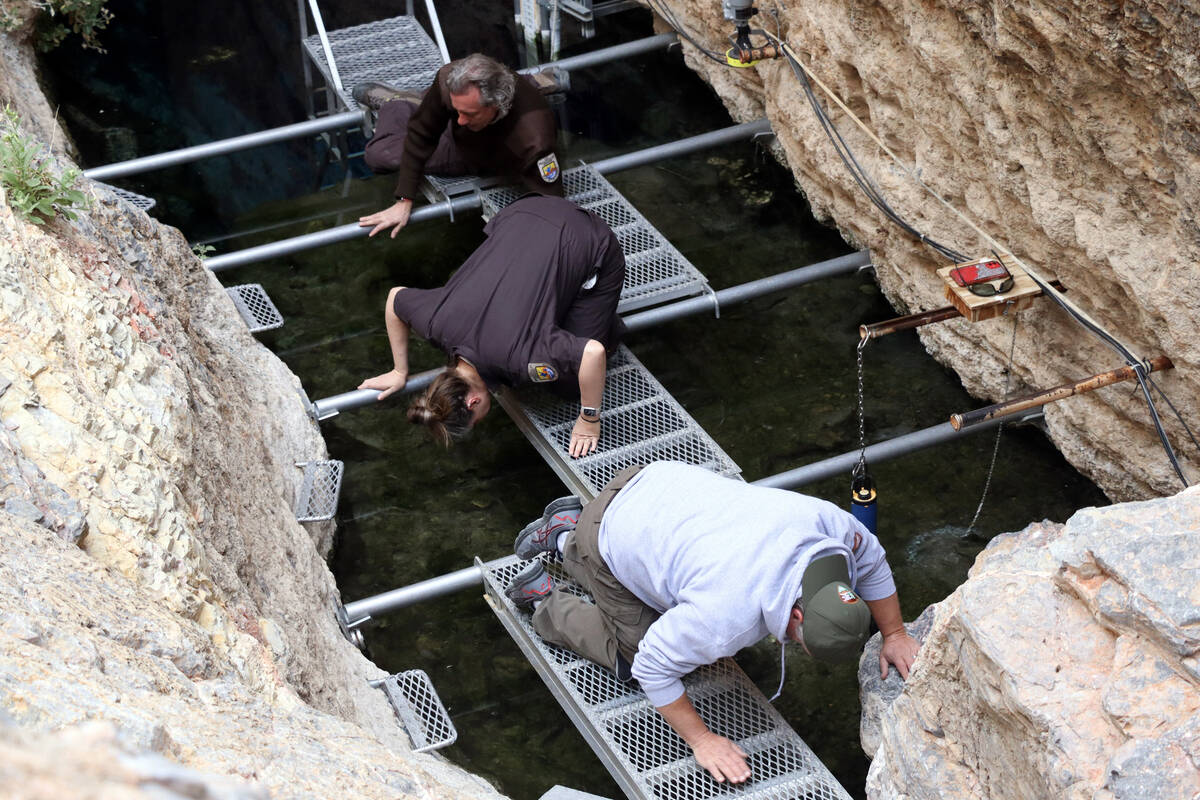Will the Devils Hole pupfish save Ash Meadows from lithium mining?
Switching on her microphone at the front of the community center, Amargosa Valley town board chair Carolyn Allen looked stoic as a mining executive tried to pitch drilling for lithium to a wary audience of her neighbors. It was her turn to have her say.
Allen has become a leader in rallying Nye County against exploratory drilling for lithium in her small town, which, in some cases may happen a few hundred feet from people’s homes and businesses.
Just more than 20 miles from the building, the world’s rarest — and arguably most protected — fish playfully dive in a delicate, caged-in spring that the U.S. Supreme Court once agreed was at risk of drying up. That fish could be key.
In the past, the Devils Hole pupfish has been far from popular in conservative Nye County, with some Nevadans angry about how a tiny fish managed to stifle urban sprawl because of a lack of water in the nation’s driest state.
Today, conservationists argue that the animal, of which scientists estimate there are about 191 in the wild, might be what protects the groundwater that sustains life in Amargosa Valley.
“The pupfish has, apparently, kept us from growing like we would have wanted to,” Allen said to the crowd of residents she represents. “But now, it’s the pupfish’s turn to save us.”
Can the Endangered Species Act trump mining law?
The Devils Hole pupfish is protected by the Endangered Species Act, the law that dedicates federal resources to preserving the country’s most imperiled plants and animals. There are other fish species granted protections in the same area.
The pupfish is also intertwined with Caeppert v. United States, a Supreme Court case that stopped groundwater pumping near Devils Hole in the ’70s and affirmed the National Park Service’s right to its water.
Then comes in mining law. Rover Critical Minerals, the Canadian exploratory drilling company that hopes to sell off its minerals in about six years, was allowed to claim its stake to the public land around Amargosa Valley thanks to the General Mining Act of 1872. The law is designed to allow broad exploration for minerals on federal land.
But the question remains of which law will hold greater weight with the Bureau of Land Management, the federal agency that permits mining on public land.
“BLM is basically saying, ‘We have conflicting mandates. We have to approve mines, but we also have to not allow harm to endangered species,’” said Patrick Donnelly, the Great Basin director of the Center for Biological Diversity who has promised to litigate against Rover’s mining activity.
Establishing a tie to pupfish
The BLM’s decision last year to revoke permission for similar exploratory drilling much closer to the pupfish habitat within Ash Meadows National Wildlife Refuge caused Rover to abandon some of its claims, CEO Judson Culter wrote in a statement.
Culter since has tried to distance its new claims from the refuge. He maintains that an independent hydrologist has confirmed that its existing claims lie within a separate hydrological basin from Ash Meadows.
“(It’s) a different basin,” Culter wrote. “A much deeper basin.”
Environmental nonprofit The Nature Conservancy conducted its own study contradicting that, making the case that the hydrological basin that sustains Ash Meadows could be greatly affected by mining in most nearby areas.
Regardless, it could take at least six years for Rover to make a sale to a multinational company that would have to go through a separate, decade-long permitting process to establish a mine. Lawsuits could extend that time frame, too.
In the meantime, town board chair Allen, along with the nonprofit Amargosa Conservancy, has been lobbying the U.S. Department of Interior to call for what’s known as a “mineral withdrawal.” It wouldn’t affect Rover, but it would mean that no new mining claims could be established in that area.
The pupfish and other endangered species dependent on groundwater at Ash Meadows might make for a more convincing argument.
Robert Fischman, an environmental law professor at Indiana University Bloomington, said Interior Secretary Deb Haaland has broad legal power to create mineral withdrawals. It’s happened before, like in 2012, when a withdrawal of roughly 1 million acres was established around the Grand Canyon because of uranium mining concerns.
“It’s not easy to get the secretary to make a withdrawal,” Fischman said. “But she certainly has the legal authority to respond.”
It’s hard to “pin the blame” on what has dissuaded mining companies from backing out of their plans throughout history, Fischman said, but the Endangered Species Act does often make permitting a mine more difficult.
Federal animal protections more relevant
Donnelly, of the Center for Biological Diversity, said the Endangered Species Act will ultimately be more relevant than the Supreme Court case in suing the BLM. That’s because the case has more to do with Nevada’s permitting of groundwater pumping than the actions of the federal government.
“Caeppert provides a kind of rich irony here,” Donnelly said. “The Supreme Court reached down and told the state of Nevada what it had to do, but a mining company might be able to come in the middle and build a mine.”
In the courtroom, Donnelly said, it will be much more difficult to argue against minimal exploratory drilling as opposed to a large mine proposal. Still, the Endangered Species Act provides a sound legal basis to fight extractive mining, he said.
“Our odds of stopping the mine are significantly better than our odds of stopping the exploration,” Donnelly said. “With exploration, it’s harder to prove that it’s going to drive something extinct.”
Contact Alan at ahalaly@reviewjournal.com. Follow @AlanHalaly on X.


















